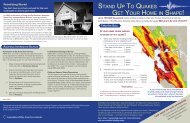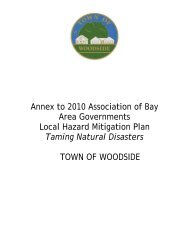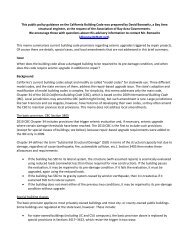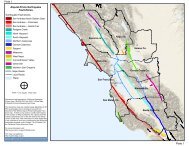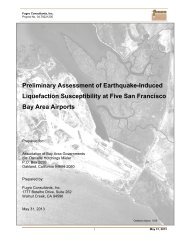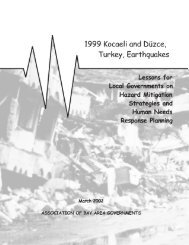Safe Enough to Stay - ABAG Earthquake and Hazards Program
Safe Enough to Stay - ABAG Earthquake and Hazards Program
Safe Enough to Stay - ABAG Earthquake and Hazards Program
- No tags were found...
Create successful ePaper yourself
Turn your PDF publications into a flip-book with our unique Google optimized e-Paper software.
<strong>Safe</strong> <strong>Enough</strong> <strong>to</strong> <strong>Stay</strong>Section I:How much of San Francisco’shousing needs <strong>to</strong> meet shelterin-placest<strong>and</strong>ards?SPUR defines “seismic resilience” as the ability of the city <strong>to</strong> containthe effects of earthquakes when they occur, <strong>to</strong> carry out recoveryactivities in ways that minimize social disruption <strong>and</strong> <strong>to</strong> rebuildfollowing earthquakes in ways that mitigate the effects of futureearthquakes. The more quickly a community can rebound from amajor event, the more resilient the community.A critical component of resilience is that residents choose <strong>to</strong> remainin the city during the recovery period. There are many fac<strong>to</strong>rs thatdetermine whether a resident will chose <strong>to</strong> stay after a disaster or pickup <strong>and</strong> leave the city. Residents may be able <strong>to</strong> cope with no wateror sewer services for a few weeks, but most will be unwilling <strong>to</strong> putup with these difficulties for a period of months. Similarly, if roads,bridges or public transportation systems are not fully functional,residents may need <strong>to</strong> relocate in order <strong>to</strong> commute <strong>to</strong> jobs <strong>and</strong>schools. The closure of schools, medical facilities or businesses couldaffect residents’ decisions about whether <strong>to</strong> stay in <strong>to</strong>wn or leave SanFrancisco. Some residents may leave right away <strong>and</strong> then return astheir fears subside, when their <strong>to</strong>ilet works again or as they completerepairs <strong>to</strong> their property. Others may stay initially but will leave asthey learn how slowly their neighborhoods will be rebuilt. Someresidents who leave may develop ties in their new community <strong>and</strong>never return.The availability of housing, jobs <strong>and</strong> community resources such asschools is critical <strong>to</strong> a city’s seismic resilience. We assume that if twoout of these three resources are in place, residents will choose <strong>to</strong>stay. For example, if a resident can shelter in place in her home <strong>and</strong>her employer has chosen <strong>to</strong> remain in the city, she is more likely <strong>to</strong>stay than if her employer has left the city or if she is unable <strong>to</strong> remainin her home.Economic recovery <strong>and</strong> housing recovery are interdependent. Ifemployers choose <strong>to</strong> leave the city or region, they take jobs withthem. If residents leave, the workforce that employers rely upon is nolonger available, leading <strong>to</strong> further disinvestment. Young <strong>and</strong> mobileresidents, such as high-tech workers who have not yet establisheddeep ties <strong>to</strong> the community, may leave after the earthquake if thecharacteristics that attracted them <strong>to</strong> San Francisco — exciting jobs,an active cultural life <strong>and</strong> a vibrant social scene — are no longer inplace. Keeping San Francisco’s workforce from leaving is key <strong>to</strong> thecity’s economic recovery.It is also crucial that San Francisco plan for its most vulnerablepopulations: low-income households, the elderly, non-Englishspeakers <strong>and</strong> the disabled. It is clear that some residents will suffermore severe consequences than others if they are displaced fromtheir homes by an earthquake. Wealthy residents have options:They can stay in a hotel in the short term, find rental housing forthe medium term, secure loans, begin repairs on buildings theyown before insurance payments come through, <strong>and</strong> purchasereplacements for personal items that they lost. Low-income residentscan do few of these things. They will rely heavily on city shelters <strong>and</strong>services. Many of them may leave, unable <strong>to</strong> afford new rental unitsin a market with reduced availability.For low-income property owners, selling damaged property may bemore feasible than obtaining financing <strong>and</strong> undertaking repair <strong>and</strong>reconstruction. Middle-class residents, already tightly squeezed bySan Francisco’s expensive real estate market, will also have difficultystaying in the city. Elderly residents will be heavily affected. Seniorsof all income levels, but particularly seniors on a fixed income,will find it difficult <strong>to</strong> relocate, repair or rebuild their homes <strong>and</strong>reestablish needed social services <strong>and</strong> networks. A large earthquakecould permanently alter city demographics <strong>and</strong> increase the pace ofchange in many neighborhoods. San Francisco’s diversity <strong>and</strong> culturewill be threatened if vulnerable populations leave due <strong>to</strong> lack ofaffordable <strong>and</strong> accessible housing.While this report is focused on one fac<strong>to</strong>r — housing — there isno doubt that other fac<strong>to</strong>rs are also important <strong>to</strong> recovery. SanFrancisco’s down<strong>to</strong>wn is a major regional job center, home <strong>to</strong> morethan 250,000 jobs. About 42 percent of these down<strong>to</strong>wn workerslive in San Francisco, <strong>and</strong> about 38 percent commute from the EastBay. Many of San Francisco’s major employers (such as PG&E, WellsFargo, the Gap, Charles Schwab, Macy’s West, Levi’s <strong>and</strong> McKesson)have corporate headquarters or significant numbers of employees inSan Francisco’s down<strong>to</strong>wn core. These employers, along with smallerones, represent important sec<strong>to</strong>rs of the San Francisco economy thatwill be key <strong>to</strong> recovery: public utilities, <strong>to</strong>urism, <strong>and</strong> hospitality <strong>and</strong>business services.6 SPUR Report > January 2012



